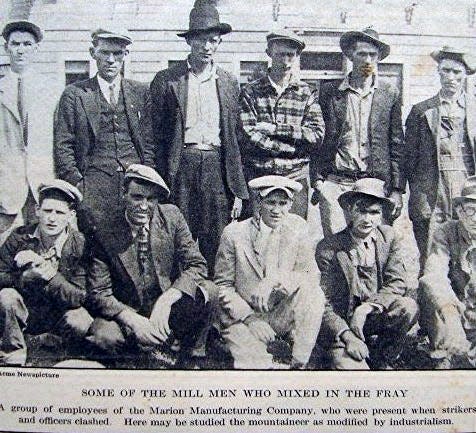Asheville area Labor Day history: Striking mill workers killed by deputies
- Oops!Something went wrong.Please try again later.

Western North Carolina owns one of the darkest chapters in Southern labor history, dating back nearly a century: on Oct. 2, 1929, sheriff's deputies in Marion killed six and wounded more than a dozen striking textile workers.
Here are some of the facts about the bloody labor conflict 40 miles east of Asheville that inspired a song by Woody Guthrie and a book by Nobel Prize winner Sinclair Lewis:
(Sources include past Citizen Times reporting and "A Missing Mountain Memory: The Marion Mill Strike of 1929" by Meg Stevens.)
More: Crow & Quill, Green Sage may be the beginning of local service industry union movement
In 1928 and late 1929, unrest among Marion Manufacturing's 650 workers was coming to a head over dilapidated, crowded mill housing and a move by management to increase the 12-hour shifts with no additional pay.
Workers began to organize and reached out to the United Textile Workers Union. Opponents characterized labor organizers as communists.
In February 1929 there were reports of an explosion at company president R.W. Baldwin's house that was attributed to pro-labor workers.
Workers at Marion Manufacturing went on strike for a first time on July 11. They were joined by workers at Clinchfield Mills in East Marion. Company officials attempted to remove strikers from mill housing. Explosions were reported around the mill village and two strikers were shot. National Guard troops were sent to Marion. The strike ended Sept. 11, though the company did not rehire 114 of the striking workers, a source of continuing angst for pro-union workers.
On Oct. 2, Marion Manufacturing workers staged an early-morning walk out, this time without Clinchfield workers. Deputies fired on the strikers killing two and mortally wounding four. More than a dozen others were wounded. Eight deputies acquitted of murder swore strikers were armed, though the workers said they had no weapons and had no intent of violence.
The hospital denied treatment to wounded strikers, since the company would not cover their bills. Killed workers did not receive church funerals after those in charge of local congregations distanced themselves from the situation. Still, over 1,000 mill workers and their families attended the services.
Sinclair Lewis, author of "Babbitt," was working as a journalist at the time and came to Marion to cover the events, later writing the book "Cheap and Contented Labor: The Picture of a Southern Mill Town in 1929."
Inspired by the events, social activist and musician Woody Guthrie wrote the song "The Marion Massacre."
Large numbers of pro-union workers left the area and the labor unrest became a painful memory that many chose to try to forget. That changed in part with a memorial dedicated to the slain workers. They were: Luther Bryson, 23; T. L. Carver, 50; Randolph Hall, 22; George Jonas, 65; J. Will Roberts, 18; Sam Vickers, 54.
More: Fletcher man's death after being tasered, punched, restrained by police not a crime: DA
Mission's security approached union nurses handing out flyers: 'We're following orders'
Joel Burgess has lived in WNC for more than 20 years, covering politics, government and other news. He's written award-winning stories on topics ranging from gerrymandering to police use of force. Got a tip? Contact Burgess at jburgess@citizentimes.com, 828-713-1095 or on Twitter @AVLreporter. Please help support this type of journalism with a subscription to the Citizen Times.
This article originally appeared on Asheville Citizen Times: Asheville area Labor Day history: Deputies kill striking mill workers
